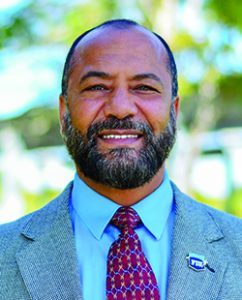
We talk with leading educators and researchers to learn more about the people and topics of asphalt technology.
Dr. Ali Hesham, Ph.D., P.E., C.P.M. is the Green Paving Professor of Practice at Florida International University’s Department of Civil and Environmental Engineering.
What drew you to transportation engineering?
The transportation system is like the blood vessels in a human body, without them, the body does not function. The growth and development of a nation are tied to its transportation system. Many attribute Great Britain’s success in the past to its effective transportation systems. In the U.S., pavements are among the most extensive assets with more than three million miles of paved roads. It is hard to turn away from the opportunity to make a difference at this scale.
How is the Florida Texture Meter changing the way we can detect asphalt pavement segregation?
Florida Texture Meter (FTM) is a tool developed by FDOT to quantify asphalt texture and detect segregation. FTM is a portable laser-based device that measures the surface texture of pavement in terms of mean profile depth. Segregation is the separation of coarse and fine aggregates which causes the asphalt to have more voids, hold more water and deteriorate faster over time. Segregation has been traditionally identified by visual inspection. FTM measurements, when coupled with core density data, can give a good indication of segregation. FDOT is evaluating the implementation of this concept in asphalt quality control and acceptance.
How can pavement raveling be effectively investigated using a smartphone?
We investigated the raveling of open graded friction course (OGFC) in Southeast Florida. OGFC is used in all high-speed roads in Florida. In the process, we developed a simple tool. We used a smartphone mounted on a car windshield to video the pavement at the speed of traffic. Cellphones can keep track of the picture location in the form of coordinates. We wrote a simple program to extract location data and compute the raveled area, extent and severity of raveling. This allowed us to expedite the work and improve the safety of our data collection crew. Once the raveling statistics were compiled, we correlated raveling with construction and material data and developed guidance to reduce OGFC raveling.
What is your vision for 3-Dimensional paving?
In 2018, the U.S. Patent Office awarded a patent to FIU, entitled “Three-Dimensional Paving.” The free-floating screed has drawbacks that include a lack of precise control of the paving profile, restrictions on paving thickness and the expense of highway paving components. Our proposed approach replaces the mechanical screed with a series of 3-dimensional nozzles. This allows a precise elevation control, perfect profile both in the longitudinal and transverse directions of the road and lower restrictions on the layer thickness. The system can be produced for less than half the cost of a conventional screed paver.
In what area should today’s students focus their asphalt research?
There is a paradigm shift in the civil engineering world. It is not enough for roads to be made of static material serving a single purpose. There is a big push to make everything smart, multipurpose and more sustainable. From embedding sensors in a road to measure its structural response to generating solar energy, to embedding hardware to support autonomous vehicles. We see an avalanche of technologies that are now ripe to improve pavement sustainability. Examples include increased potential to recycle more asphalt with the advances in recycling agents, warm mix additives and material characterization technology. There is increased opportunity for robotics and 3-dimensional paving techniques to replace conventional paving. We are moving into the next era with artificial intelligence.













